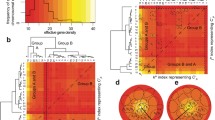Abstract
THE existence of differential chromosome contraction1–3 presents difficulties for morphometric chromosome analysis. Spiralisation rates of all the chromosomes change simultaneously4, and the sizes of all the chromosomes in the set must be correlated with one another, and also with the extent of contraction; the latter may be expressed as the total complement length (the total length of the chromosome complement).
Similar content being viewed by others
References
Longley, A. E., Bot. Rev., 7, 269 (1941).
Sasaki, M., Chromosoma, 11, 514 (1961).
Takehisa, S., Jap. J. Genet., 38, 237 (1963).
Bajer, A., Hereditas, 45, 579 (1959).
Iordansky, A. B., Krumin, A. R., Pavulsone, S. A., Badaev, N. S., and Deryaguin, G. V., Dokl. Akad. Nauk SSSR, 201, 469 (1971).
Gindilis, V. M., Tsitologiya, 8, 144 (1966).
Iordansky, A. B., Krumin, A. R., Pavulsone, S. A., Badaev, N. S., and Deryaguin, G. V., Tsitologiya, 16, 287 (1974).
Author information
Authors and Affiliations
Rights and permissions
About this article
Cite this article
IORDANSKY, A., DERYAGUIN, G., BADAEV, N. et al. Influence of differential chromosome spiralisation on karyotype morphology. Nature 253, 734–735 (1975). https://doi.org/10.1038/253734a0
Received:
Published:
Issue Date:
DOI: https://doi.org/10.1038/253734a0
- Springer Nature Limited
This article is cited by
-
Heteropycnosis of an underreplicating chromosome
Chromosoma (1990)
-
Linear differentiation of cereal chromosomes
Theoretical and Applied Genetics (1978)





